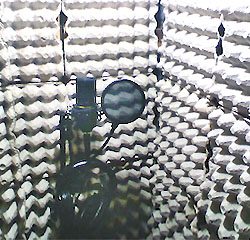
Rubber—Floor matts, mouse pads, neoprene, or any other variation of rubber will do very little to stop sound coming or going from your room.
Once again, it’s much cheaper to buy proper acoustic materials that are easier to work with, but they won’t help your isolation problem either.
Wall Cellulose—Pumping cellulose insulation into walls can make a slight difference, but it’s marginal since there are much more effective ways to improve the isolation that are much cheaper.
It can be helpful if used along with some other techniques, but isn’t particularly effective by itself.
Fiberglass Insulation—Common fiberglass insulation once again has little ability to stop enough of the low frequencies that bug your neighbors, although, like with blown cellulose, it can be useful in conjunction with other techniques. Just pinning it to the wall won’t help though, but it will affect the acoustics of the room.
It’s also a skin and eye irritant, takes up a lot of space, and the dust can be hazardous to your lungs when left exposed. As you’ll soon see, there’s a much better way to use fiberglass for acoustic control (although it still won’t help with isolation much).
Plywood Panels—It’s true that plywood panels provide mass and mass is what’s needed to stop sound transmission (especially the low frequencies), but the problem is that wood transfers sound too well so the construction technique used is crucial.
Not only that, if the panels are too thin they’ll resonate and vibrate, causing an even bigger problem.
Particle Board—See plywood panels.
Bales Of Hay—Unless you live out in the country, it’s unlikely that hay bales are much of an option, but they actually do work. The problem is that they take up a lot of usable space, make a nice home for critters, and are a major fire hazard. Not recommended!
Acoustic Foam—Acoustic foam is helpful in controlling the acoustics within a room, but it does nothing to stop sound transmission and is expensive to boot. Acoustic foam doesn’t even begin to affect the offending low frequencies, and using too much just makes the room seem dead and uncomfortable. There are much cheaper ways to achieve a better result.
Understand that all of these materials will have at least some affect on the sound of the room (which we’ll cover later in the chapter), but will do almost nothing by themselves to help improve your isolation.
Bobby Owsinski is an author, producer, music industry veteran and technical consultant who has written numerous books covering all aspects of audio recording. For more information be sure to check out his website and go here for more info and to acquire a copy of The Studio Builder’s Handbook.
